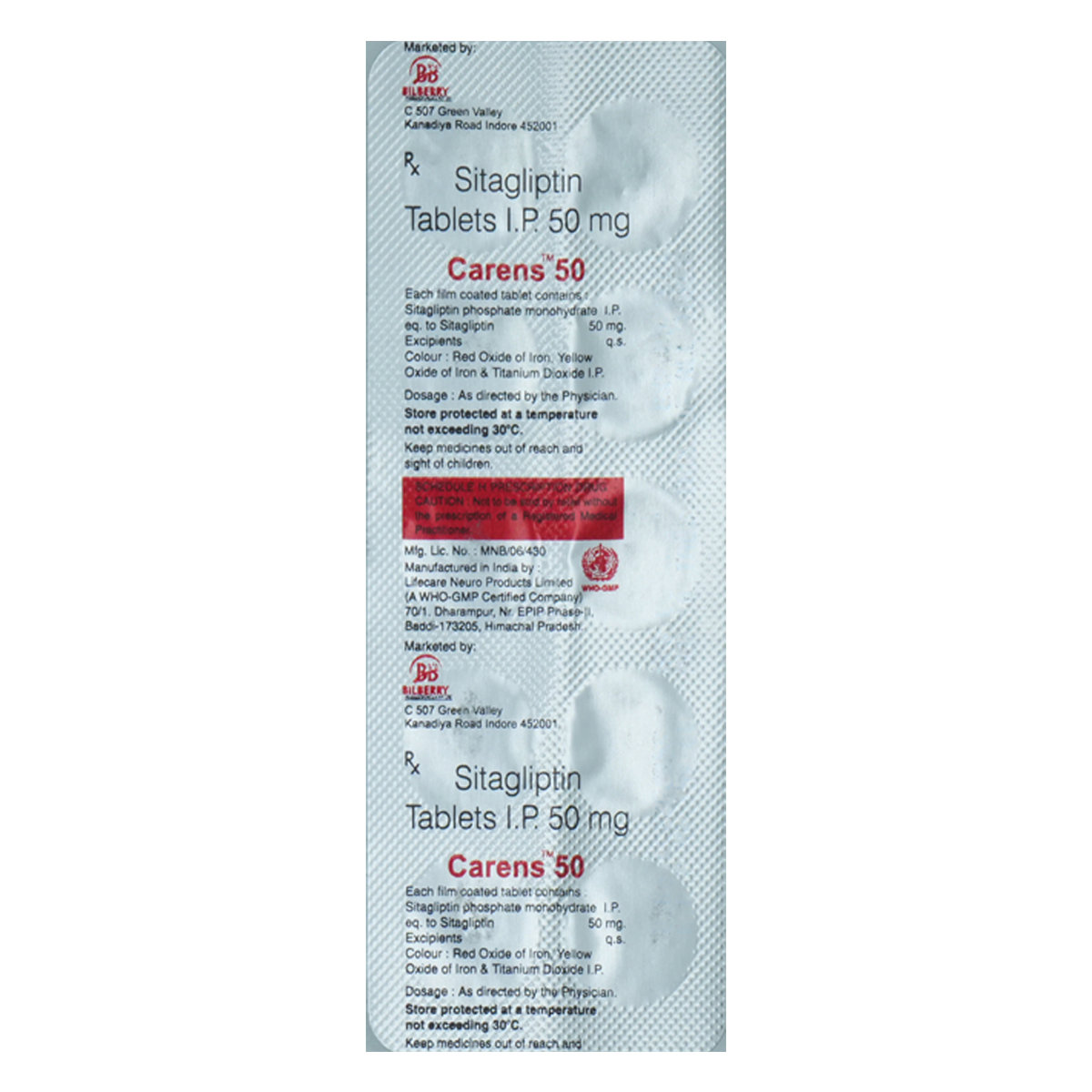Sitagliptin
About Sitagliptin
Sitagliptin belongs to the class of dipeptidyl peptidase-4 (DPP-4) inhibitors used in treating type 2 diabetes in adults. Sitagliptin is prescribed for the condition of type 2 diabetes when diet and exercise alone cannot control their blood sugar levels. It is the first-line therapy for patients with type 2 diabetes that restores the body's response to insulin. Insulin is the hormone that controls sugar levels in your blood. People with type 2 diabetes either do not produce enough insulin, or the insulin produced cannot perform its function in the body (insulin resistance). Middle-aged or older individuals are most likely to suffer from type 2 diabetes, so it is also known as adult-onset diabetes.
Sitagliptin contains sitagliptin. Sitagliptin work by blocking the action of DPP-4 (an enzyme which destroys the hormone 'Incretin'). The enzyme 'Incretins' helps produce more insulin only when required and reduces blood sugar produced by the liver when not needed.
Sitagliptin should be taken with food or an empty stomach. However, it should be taken at the same time of the day each time for the best results. For better advice, your doctor will decide what dose should be taken, which can change quickly depending on your condition. The most common side effect of Sitagliptin is hypoglycaemia (low blood glucose levels), upper respiratory tract infection, nasopharyngitis (infection of the nose and throat with common cold) and headache.
Sitagliptin should not be used in patients with type 1 diabetes and for treating diabetic ketoacidosis. Sitagliptin should not be stopped even if you feel better without consulting your doctor as the sugar levels change. If you stop taking Sitagliptin abruptly, it may increase your sugar levels which could further increase the risk of eyesight loss (retinopathy), kidney (nephropathy) and nerve damage (neuropathy). Sitagliptin should not be taken if you have severe kidney or liver disease. Please inform your doctor if you have any heart disease or planning to get pregnant or breastfeed. Prolonged intake of Sitagliptin may cause acute pancreatitis (swollen pancreas) and critical kidney problem. Increased risk of hypoglycaemia (low blood sugar level) can occur when Sitagliptin is added to other anti-diabetic agents or insulin therapy. In this case, your doctor may adjust the dose of Sitagliptin. Severe allergic reactions might occur in some patients taking Sitagliptin like anaphylaxis, angioedema (swelling under the skin), and exfoliative skin conditions, including Stevens-Johnson syndrome. The safety and efficacy of Sitagliptin in children under 18 years have not been established, so it should not be given to them. Patients taking digoxin (a heart medicine) with Sitagliptin should be closely monitored as severe drug interaction has been observed.
Uses of Sitagliptin
Medicinal Benefits
Sitagliptin work by blocking the action of DPP-4 (an enzyme which destroys the hormone ‘Incretin’). The enzyme ‘Incretins’ helps produce more insulin only when required and reduces blood sugar produced by the liver when not needed. Thus, Sitagliptin plays a vital role in controlling blood sugar levels and prevents serious complications of diabetes like eyesight loss (retinopathy), kidney (nephropathy), nerve damage (neuropathy), diabetic foot ulcer and delayed wound healing.
Directions for Use
Storage
Side Effects of Sitagliptin
- Hypoglycaemia (low blood glucose levels)
- Upper respiratory tract infection
- Nasopharyngitis (infection of nose and throat with common cold)
- Headache
Drug Warnings
Tell your doctor before consuming Sitagliptin if you have allergic reactions to sitagliptin, any medications, foods, or any components present in Sitagliptin. Prolonged intake of Sitagliptin may cause acute pancreatitis (swollen pancreas) and critical kidney problem. Increased risk of hypoglycaemia (low blood sugar level) can occur when Sitagliptin is added to other anti-diabetic agents or insulin therapy. In this case, your doctor may adjust the dose of Sitagliptin. Severe allergic reactions might occur in some patients taking Sitagliptin like anaphylaxis, angioedema (swelling under the skin), and exfoliative skin conditions, including Stevens-Johnson syndrome. The safety and efficacy of Sitagliptin in children under 18 years have not been established, so it should not be given to them. Patients taking digoxin (a heart medicine) with Sitagliptin should be closely monitored as severe drug interaction has been observed.
Drug Interactions
Drug-Drug Interactions: Sitagliptin interacts with anti-depressant medications (bupropion), drugs used to treat glaucoma, antibiotics (cephalexin, ciprofloxacin), anti-acidity drugs (cimetidine), heart condition drugs (digoxin), anti-HIV drugs (dolutegravir), ethanol, saliva reducing drugs (glycopyrrolate), iodinated X-ray contrast agents, anti-epileptic drugs (topiramate, lamotrigine), heart-related chest medicine (ranolazine). Other drug interactions can contribute to increased low blood sugar, including sex hormones (androgens), anti-oxidant (alpha-lipoic acid), painkillers (aspirin), anti-TB drugs (prothionamide), growth hormones (pegvisomant), and other antidiabetic medicines.
Drug-Food Interactions: Intake of excessive alcoholic beverages may increase the chance of a life-threatening condition known as Lactic Acidosis. So, avoid intake of alcoholic beverages with Sitagliptin.
Drug-Disease Interactions: Sitagliptin should be used with caution in patients with a history of pancreatitis/pancreatic disease and renal dysfunction.
Drug-Drug Interactions Checker List:
Safety Advice

Alcohol
cautionNo interaction was found. However, it is advisable not to take or limit alcohol as a precautionary measure.

Pregnancy
cautionSitagliptin is not suggested during pregnancy since there is insufficient evidence on how it may impact a growing infant.

Breast Feeding
unsafeConsult your doctor; there is no substantial research yet on using Sitagliptin in breastfeeding/nursing mothers. Sitagliptin should be used in breastfeeding mothers only if the benefits outweigh the risks.

Driving
cautionSitagliptin should not impair your ability to drive, or operate machinery or tools if your blood sugar levels are stable. When your blood sugar levels drop too low, your concentration suffers. If this occurs, refrain from driving or using equipment or tools until you feel better.

Liver
cautionIn rare cases, liver enzyme elevations have been reported in the prolonged usage of Sitagliptin. So, if you have or have a history or evidence of any liver-related diseases, please consult the doctor before taking medicine.

Kidney
unsafeAcute renal failure has been reported in the patients taking Sitagliptin. In severe cases, it sometimes requires dialysis. Hence, dosage adjustment can be recommended in patients with moderate or severe kidney disease and patients with kidney failure (ESRD - end-stage renal dialysis).

Children
unsafeThe safety and efficacy of Sitagliptin in children have not been established.
Habit Forming
Diet & Lifestyle Advise
- Invest at least 150 min of your week in moderate-intensity physical activity or one hour and 15 minutes of high-intensity exercise every week.
- Losing weight gradually to achieve a healthy body mass index (18.5 to 24.9).
- Replacing refined carbohydrates-containing foods with whole grain foods and increasing intake of fruits, veggies, and other fibre-enriched foods.
- Reduce saturated fat intake (or hidden fats) in food like chips, crisps, pastries, biscuits and samosas. Choose omega-3 fatty acid-containing oils for daily cooking. For frying, you can use palm oil, mustard oil, groundnut oil, rice bran oil, and safflower oil.
- Avoid taking too much stress as it may elevate your blood sugar level. You can adopt stress management techniques like mindfulness to control stress-related blood sugar changes or meditation or yoga.
- Opt for low-fat dairy products (low-fat yoghurt, fat-free milk and cheese etc.).
- Keep your blood pressure as normal (140/90) as possible as it reduces the risk of cardiovascular diseases in diabetes patients.
Patients Concern
Disease/Condition Glossary
Type 2 diabetes is a condition where the body is unable to make sufficient insulin, or the insulin that it makes doesn't work properly or is utilized by our body. This can cause high blood sugar levels (hyperglycaemia). Symptoms of type 2 diabetes include increased thirst, frequent urination at night, slow wound healing, increased hunger, fatigue, and blurred vision. In some cases, weight gain may occur, while in rare cases, weight loss may be observed. The complication of type 2 diabetes also include neuropathy (nerve problems), nephropathy (kidney problems), retinopathy (damaged retina of eyes or blindness), loss of limbs, sexual dysfunction, and an increased chance of heart attack or stroke.





